by Winding Pathways | Mar 20, 2025 | Chickens
We have a DEI Chicken Flock. Diversity, Equity, and Inclusion in chickens??? Yes! A smart way to husband animals. And honor people, too.
DEI Variety
Within our small flock are chicken breeds with various body types, feather colors, origins, and dispositions. Here’s what we have:
- Light Brahmas are huge with a quiet personality and mostly white feathers. Their distant ancestry may be traced back to Asia, so they’re named after the Brahmaputra River.
- New Hampshire Reds are medium-sized hard-working brown egg layers with light reddish feathers. They’re Yankees to the core. Industrious. Taciturn. Weather tough.
- Delawares are another medium-sized brown-egg layer with mostly white feathers and a name honoring our second smallest state.
- Mystic Onyxes, bred by Hoover’s Hatchery, are jet black and socially reserved.
- Buff Cochins are huge birds with fluffy-buffy feathers. Only modest brown egg layers but friendly. Cochin is a region in Southern Vietnam.
- California Whites are nervous fast-moving white-egg layers always on the lookout for predators…..and they’ll let the flock know when they see one. It’s named for our most populous state.
-
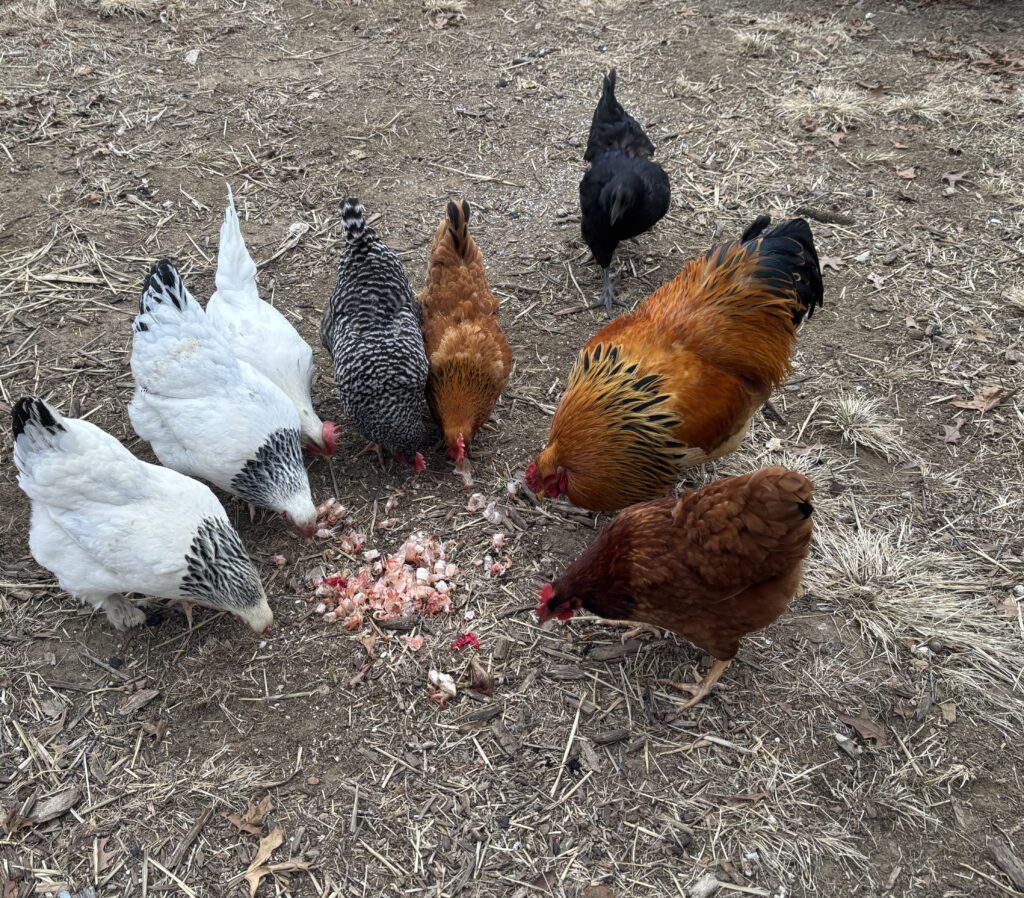
-
Gathering around
-
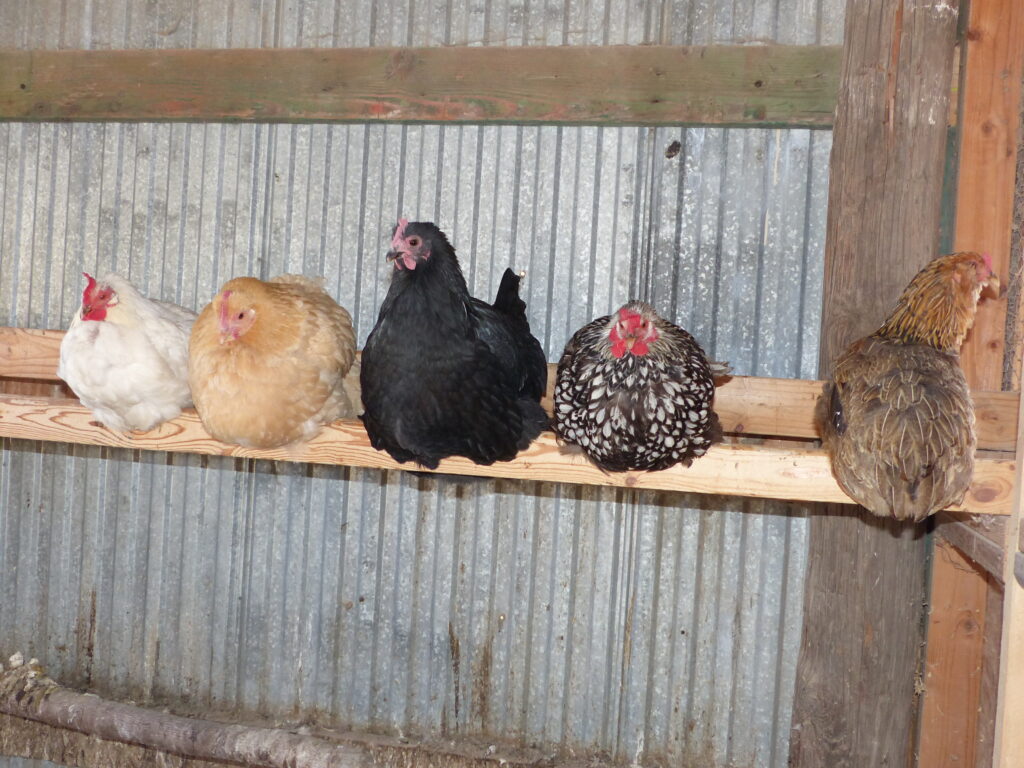
-
Roosting comfortably
-
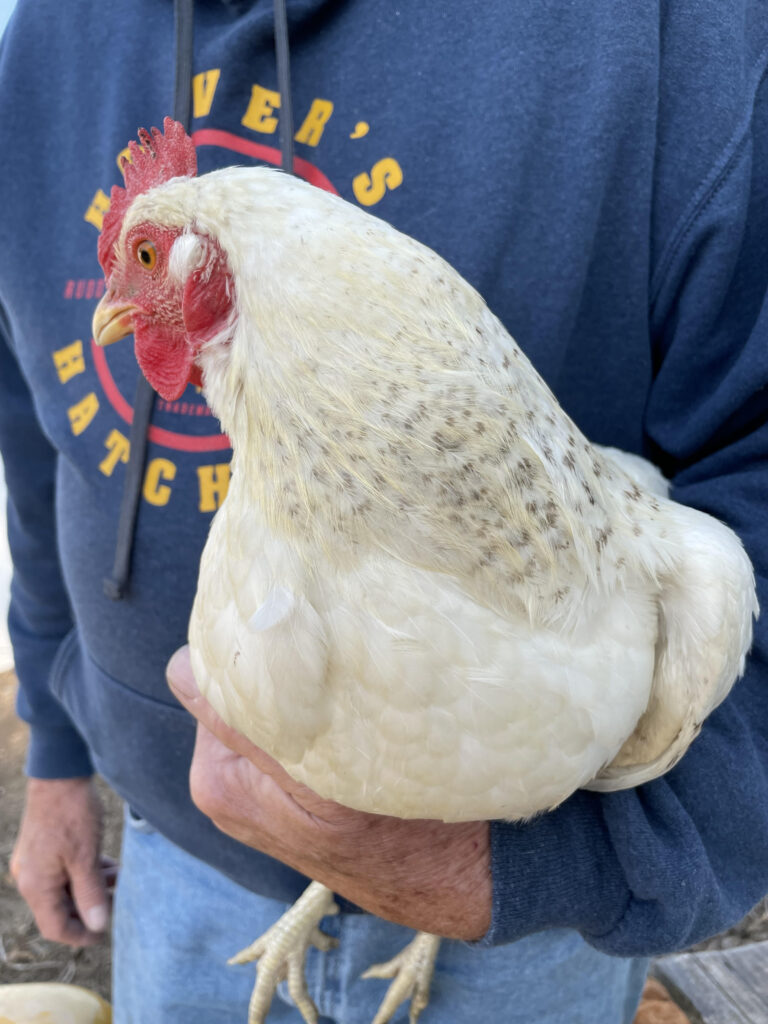
-
Delawares are elegant hens.
Blending Characteristics
Our DEI chicken flock of mixed breeds includes a blend of good characteristics. Together they create a community of diversity and strength. Occasionally they have a kerfuffle. Don’t we all? Mostly they get along with each other and help each other out. Partly because we give them space and good living quarters, and treat them kindly. It’s a resilient, mutually supportive, and productive flock. We treat them all equally and humanely. In return they eat food scraps (no waste into the sewer system or landfill), give us their jewel eggs, and entertainment as we chuckle at their antics.
-
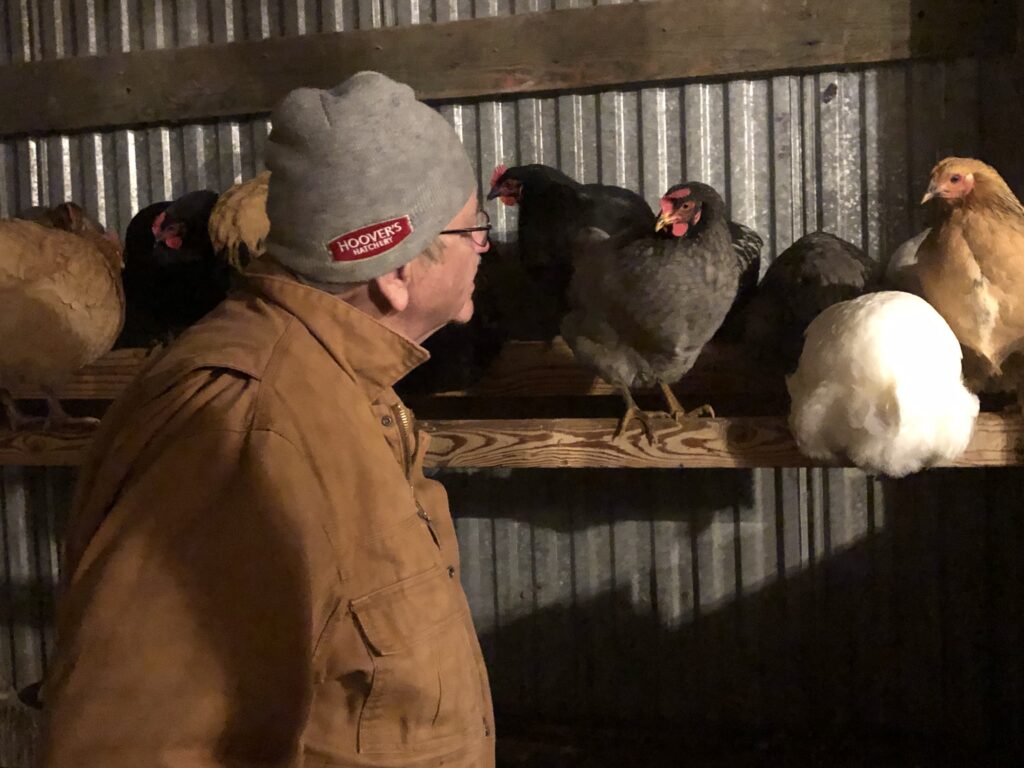
-
Cozy roosting on cold winter night.
-
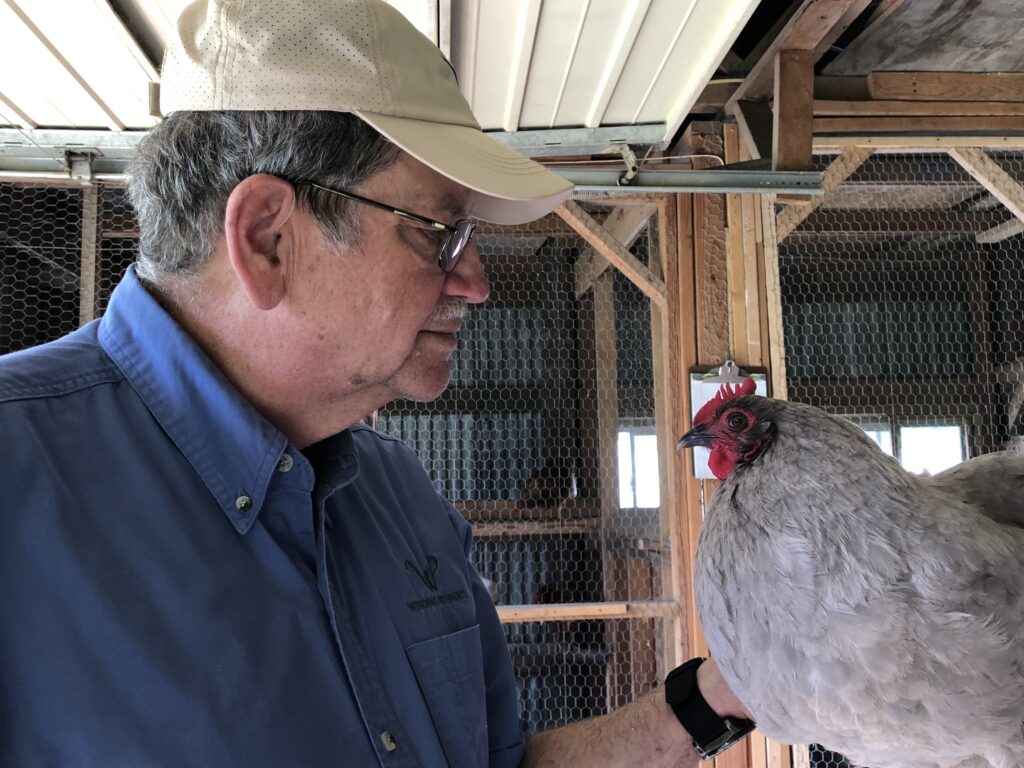
-
People can learn a lot by chatting with chickens.
-
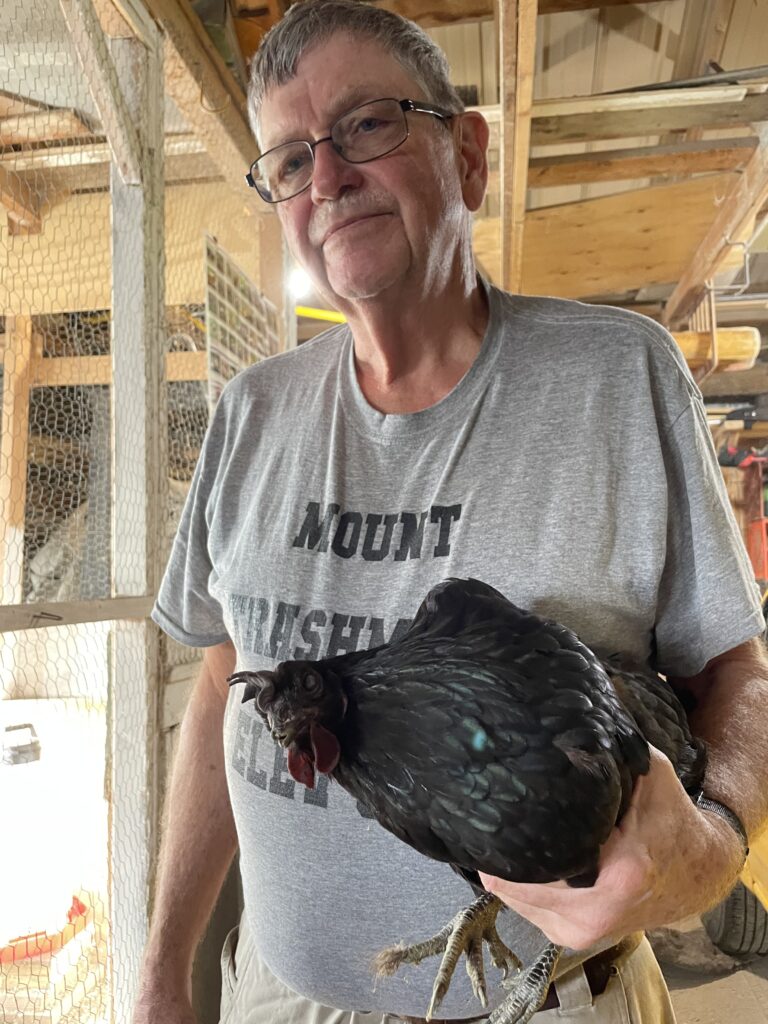
-
Iridescence of feathers.
-
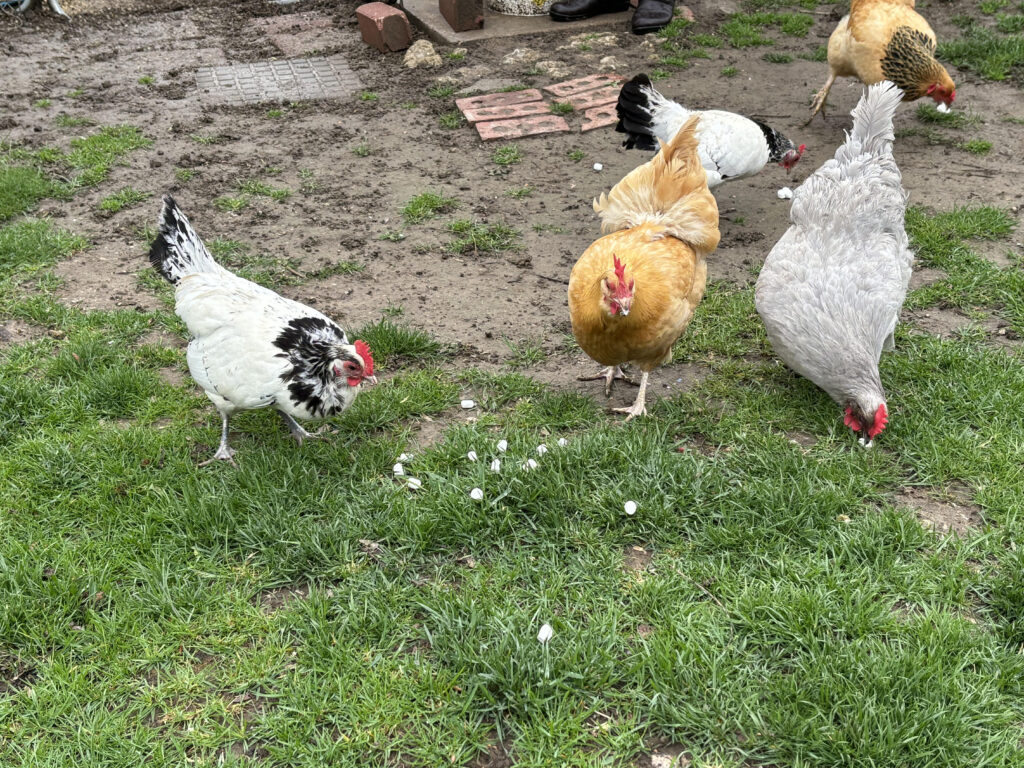
-
Chickens love treats!
-
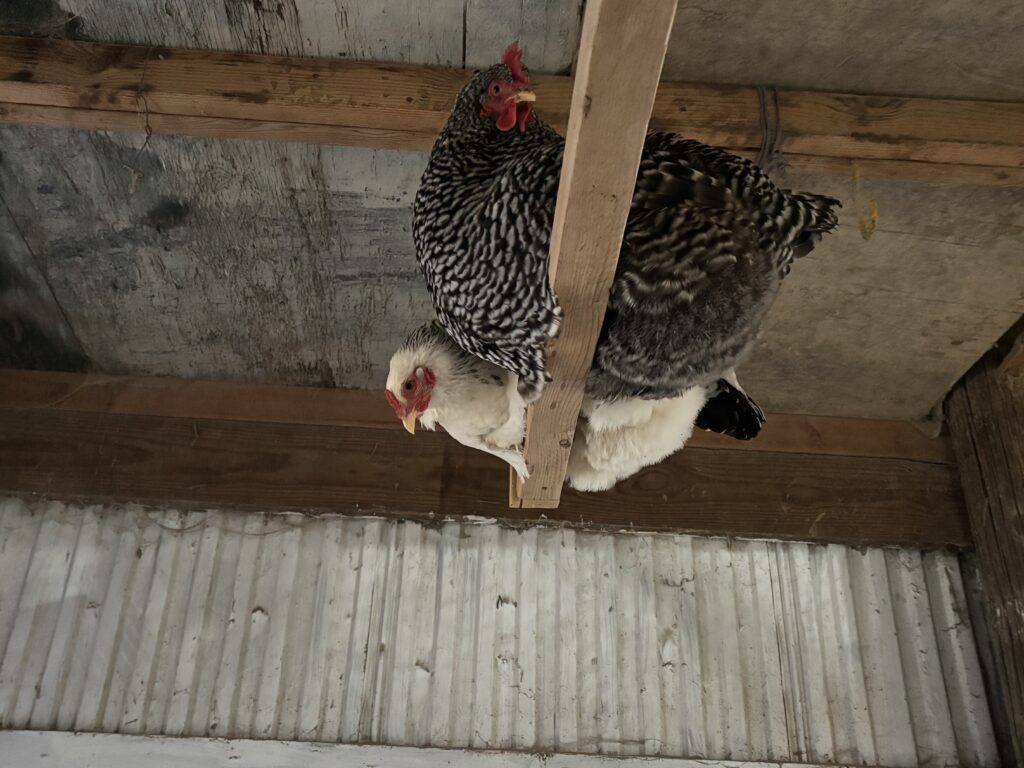
-
Chickens roost up high.
-
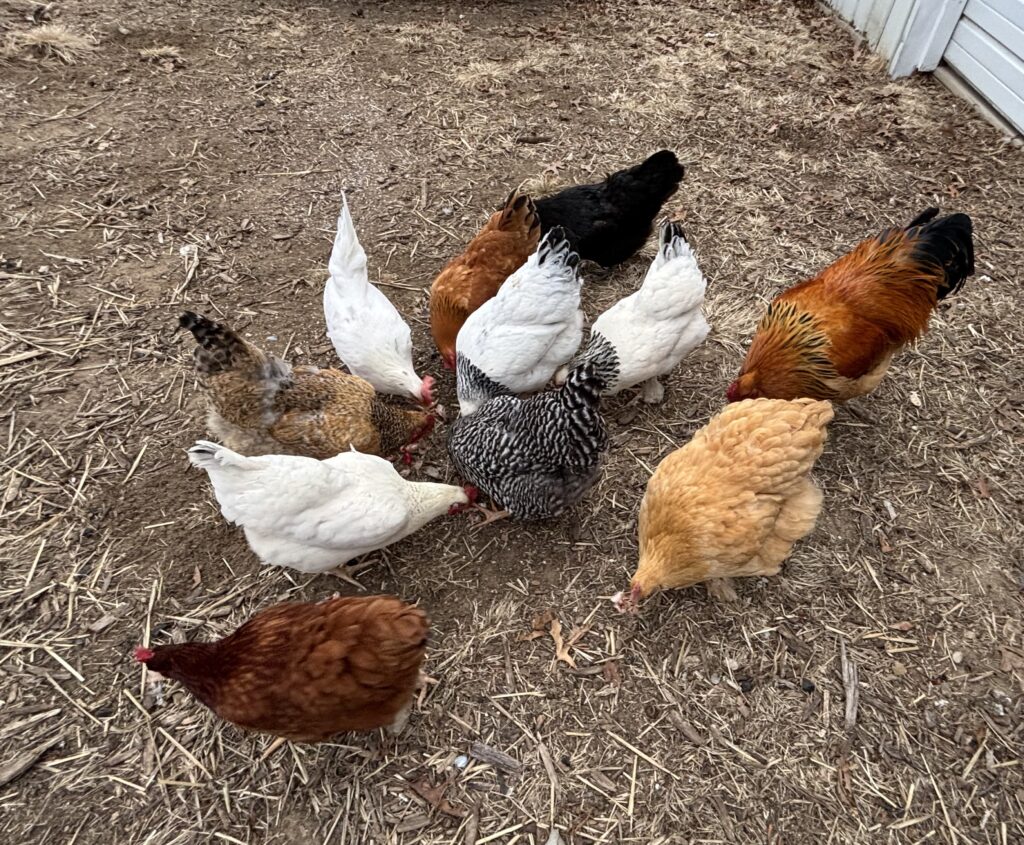
-
Note the colors & sizes.
Lessons
We have had chickens for decades. Even as young kids. Our chickens always teach us about personality diversity. Each chicken breed has likely common characteristics. Then, there’s personality variation within a breed. For example, we collect eggs by lifting the lid of each nest. Sometimes there’s a hen occupying it. If it’s a Black Onyx we get thoroughly scolded by her for disturbing her privacy. However, if a Light Brahma is in the nest she doesn’t seem to mind at all being spied on.
Our flock is also healthier because we DO provide space and superior nutrition, keep the coop and run clean, and remove opportunities for pests like mice and House (English) Sparrows to bring in diseases or eat valuable feed.
The same holds true for people. When we treat each other well, build on our strengths, and have open minds, everyone is better off.
As a nation, like in DEI chicken flocks, we are stronger, wiser, and healthier in diversity, equity, and inclusion.
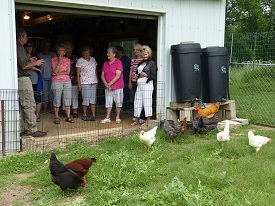
While chickens forage Rich shares about our projects.
by Winding Pathways | Mar 13, 2025 | (Sub)Urban Homesteading, Chickens, Garden/Yard
Soaring Prices Cause People to Question
Does keeping a backyard flock make sense?
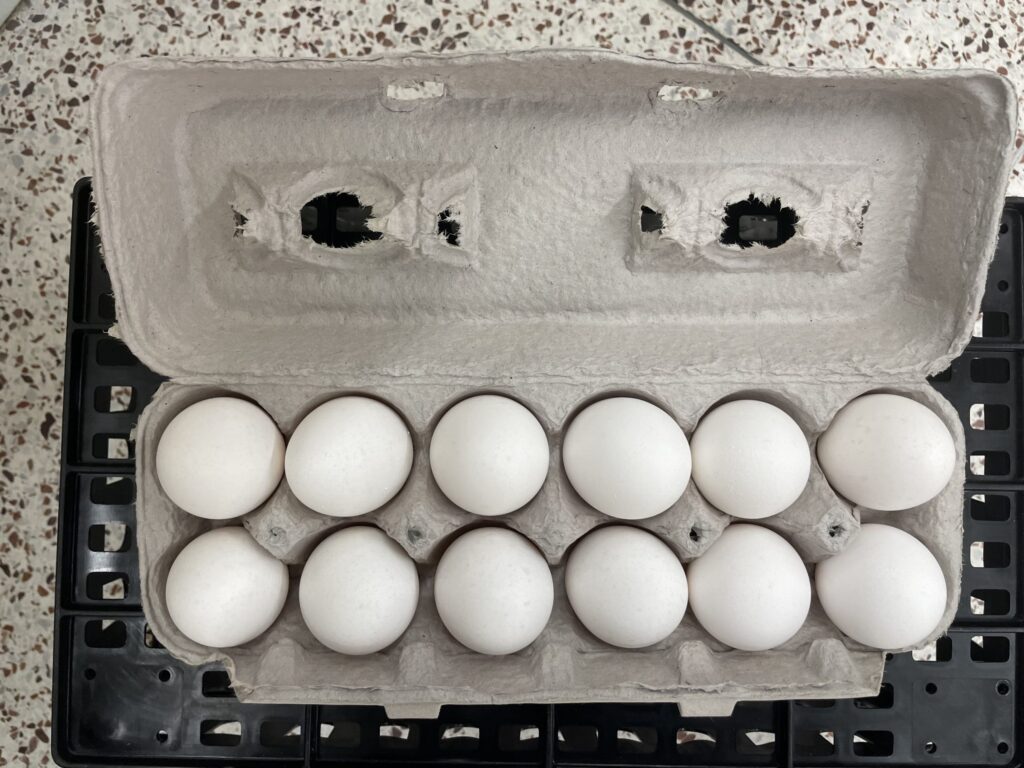
Store eggs come from one breed of chickens.
While shopping at a nearby grocery store, we noticed eggs for sale at $6 with a purchase limit of two dozen. After returning home, we visited our backyard coop and collected eight eggs, which is a fairly typical daily production from our ten hens.
With egg prices soaring and availability uncertain, many people are considering building a coop, buying chicks, and producing eggs in the backyard.
Consider Carefully
Does a backyard flock make sense, or is investing in one a way to save money? Is it a good idea to keep chickens?
It depends. Ask first, what is your lifestyle? Do you like working around a yard and tending animals? Will you keep the coop and run clean? How much space do you have for a small flock? What other animals do you have? How often do you travel? What is your relationship with neighbors? Is keeping a small flock legal in your community?
Then, do your research.
We’ve tended small backyard flocks for nearly 50 years and have much experience managing chickens. Fortunately, many towns and cities changed their ordinances to allow suburban and urban flocks and thousands of families have begun keeping chickens. For those willing to do the daily work, they are well suited for suburbia.
Will A Backyard Flock Reduce the Grocery Bill?
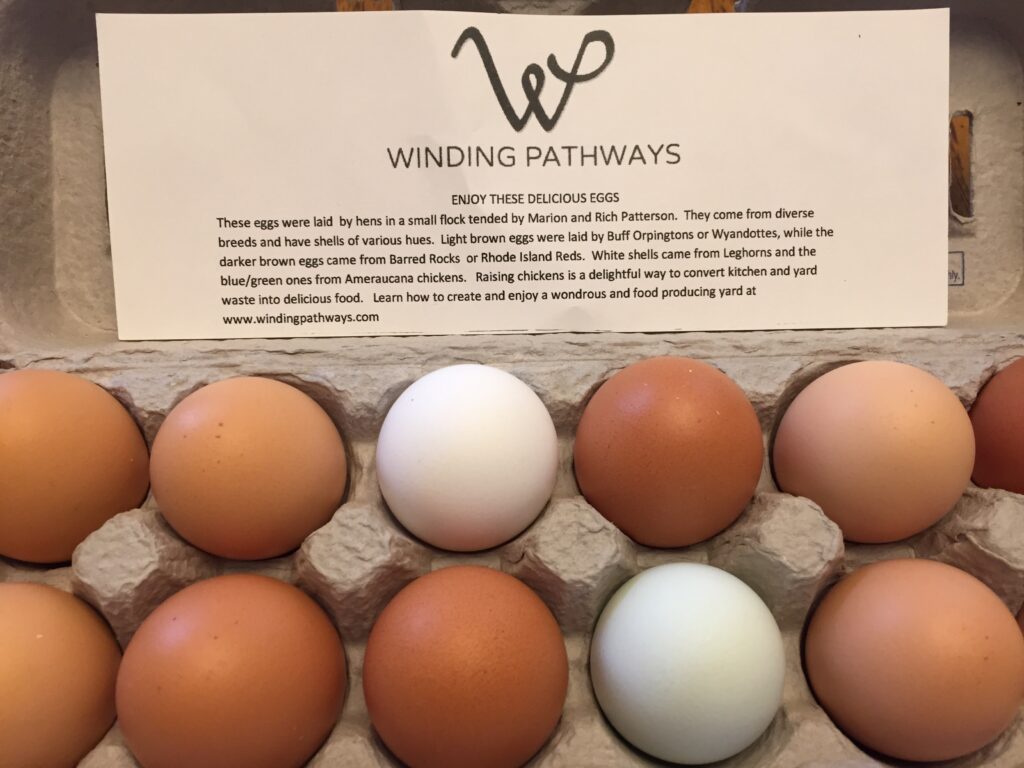
Beautiful eggs
For many families chickens are a rewarding hobby with a side benefit of delicious food and garden fertilizer. But, do those hens produce eggs at a lower price than at the grocery?
Maybe.
What is Economy of Scale?
Huge commercial egg producing farms house millions of layers of genetic strains developed for maximum egg production. They buy feed at huge discounts.
Their economy of scale has, until recently, enabled grocery stores to sell eggs at amazingly low prices.
In contrast, there’s no economy of scale in caring for a small flock. Stores offer no discounts when buying a bag or two of layer feed. It costs us about $5 a dozen to produce eggs from our ten-hen flock. So, at today’s prices we’re probably saving a little money, but during normal times our backyard eggs are more expensive than store bought ones.
More Than Money
That’s only part of the picture. We can count on our hens to lay eggs every day. Recently our grocery store was out of eggs. Reliability is a benefit and there’s more.
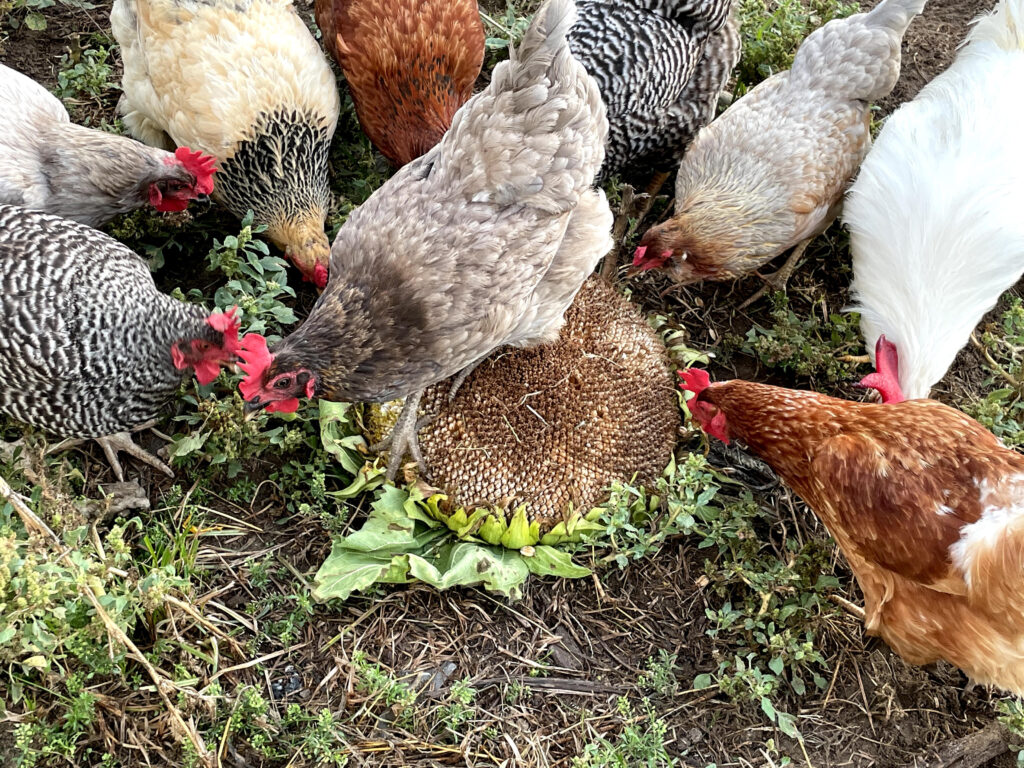
Chicken enjoy varied diet
We take pride in producing as much of our food in our yard as possible. Both garden vegetables and backyard eggs are absolutely fresh, delicious, and reliable. And, we know our chickens are raised humanely. We like them. They are fun. Our chickens give us a laugh with their comic peculiarities. They are beautiful. They talk to each other and clearly communicate, recognize us and eagerly anticipate the treats we give them daily.
Our End Benefit
For us producing food is a satisfying activity that gives us both peace of mind and pleasure.
Should A Family Tend a Backyard Flock?
Caring for any living creature entails responsibility. Chickens, like a family dog or cat, need daily care that can be time-consuming. If a family enjoys animals and is willing to devote time and energy to their daily care, a backyard chicken flock may fit perfectly into their lifestyle and yield eggs. Caring for chickens can be an enjoyable family project, an educational adventure for children with fresh eggs as a bonus.
However, if a family sees a flock solely to save money at the grocery and doesn’t enjoy daily animal care, establishing a flock is a mistake.
There’s a lot to learn when establishing a chicken hobby. Excellent information is available on our own website Winding Pathways or the Hoover’s Hatchery website. Many physical books and online sources also help with learning.
Final thought: Remember, make it fun!
by Winding Pathways | Mar 6, 2025 | Chickens, Garden/Yard
What is a Marshmallow Scramble?*
- It’s an easy, entertaining way to get chicks to come home for the night.
Every afternoon, with great enthusiasm, our chickens do the marshmallow scramble. Until recently we didn’t know chickens love the sugary balls of puff, but neighbor, Joann Hoffman, a chicken aficionado demonstrated with her small flock. As her small flock of hens gathered around her in anticipation, she tossed out a few mini marshmallows. The tiny treats vanished in a flash!
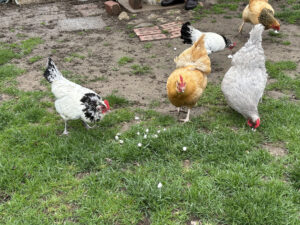
Chickens love treats!
We bought a few bags of baby marshmallows on our next foray at the grocery store. That afternoon we tossed a handful to our chickens. Cocking their heads, they eyed them with suspicion. Stepping close, cocking their heads another way, stepping away with disdain, then stepping back in as curiosity overcame their caution. One finally sampled the strange tidbit. Then, scrambled for more. Other chickens scrambled for a taste of this exotic, new “food.”
Understand, please that the marshmallow scramble is a special treat. We make sure the hens and rooster have plenty of nutritious foods and treats especially in the winter.
Now, marshmallow time happens every afternoon when we want to lure the hens into the coop for the night. They’ve even learned the phrase, “marshmallow time.” When we shout those words the flock scurries into the coop. We toss in marshmallows and enjoy watching the wild marshmallow scramble. While they’re busy snapping them up we close the pop hole door, securing the coop from nocturnal predators.
Take a look at this mad chicken marshmallow scramble.
While putting the blog together we even learned some about the history of marshmallows. Kind of interesting.
by Winding Pathways | Nov 7, 2024 | Birds, Chickens, Garden/Yard, Nature
Cardinals and other birds visiting wintery backyard feeders need grit. They’ll appreciate finding some near the sunflower seeds and millet.
The old saying that something’s as scarce as a hen’s teeth is as true for the chickadees, cardinals, and goldfinches that visit backyards as it is for the hens in our coop. Birds have no teeth. Before they can digest coarse corn and wild seeds it must be thoroughly chewed. How do they do it?
What Is Grit?
Seeing birds along wintery roads solves the mystery. They’re picking up and swallowing tiny pieces of rock that will descend into their gizzard. A gizzard is a powerful muscular pouch that grinds tough seeds against grit, resulting in a seed slurry that then moves through the bird’s digestive system. Grit is a bird’s teeth.
When Is A Good Time to Spread Grit?
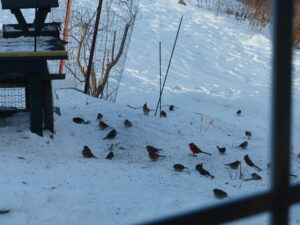
Birds flock to the seeds.
During warm months birds have no trouble finding tiny stones in bare patches of earth, but when the world is blanketed in snow or ice, they can’t find grit. Winter is when they appreciate swallowing a few tiny stones near bird feeders.
What Types of Grit Are Best?
As we fill our feeders at Winding Pathways, we sprinkle grit in with seeds and dribble some on the ground. We use two kinds of grit. When we have it on hand, we prefer baby chick grit that we buy at a farm store. It is tiny pieces of sharp quartzite that’s especially effective in grinding seeds in a gizzard. It’s sized for tiny baby chickens, so it’s just right for backyard feeder birds. When we don’t have it on hand we use regular sand. Traction and kid’s sandbox sand both work well and can be purchased at most home supply stores.
How Much Grit?
-

-
Birds flock to the seeds.
-
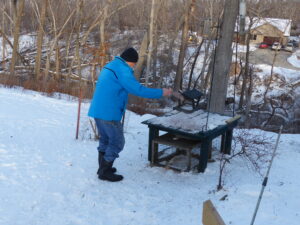
-
Sprinkle grit once a week to help birds in the snowy season.
-
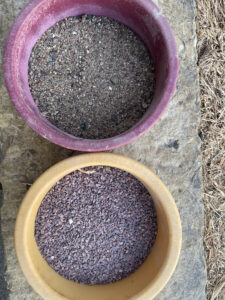
-
Spread grit when the ground is snow or ice covered.
Birds must have grit, but they don’t need much. A handful in and around feeders once or twice a week is plenty.
Other Uses
Grit’s useful around the house. When walkways are snow-slicked humans are mostly likely to slip and fall. Tossing grit on slippery walkways creates traction for people and may prevent a painful fall. Birds spot it there and occasionally pick up a few pieces. We keep about 50 pounds on hand and use most of it for traction and just a tiny fraction for our birds.
This winter when filling bird feeders scatter a bit of grit. Cardinals and other birds will appreciate it.
by Winding Pathways | Aug 15, 2024 | (Sub)Urban Homesteading, Chickens
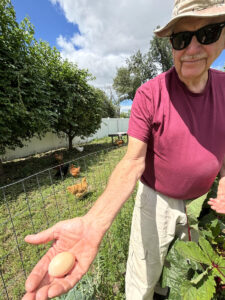
First eggs are a delight to find.
August 26th brought an unexpected and delightful surprise. We found an egg in our coop! Bringing the garden season’s first tomato, cucumber, or summer squash into the kitchen is always an event to celebrate, but it doesn’t compare to the excitement of finding the first egg.
We were expecting eggs soon, but not so soon. Our tiny baby chicks arrived from Hoover’s Hatchery on April 10th. It normally takes a female chick about 20 weeks to mature and lay her first egg. Some old-fashioned breeds don’t start laying until they’re 24 or even 30 weeks old.
We expected our small flock to start laying around Labor Day, but our first egg came when one of our pullets, or young hen, was only 18 weeks old. It was surprising.
Odd Shapes
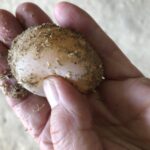
Sometimes calcium does not form on eggs.
A hen’s first eggs are small and sometimes shaped oddly. Sometimes these early eggs can be found in stores marked as, “pullet eggs”. After a few weeks of laying, her eggs reach medium or large size. Sometimes early in a hen’s laying life, she’ll lay a whopper of an egg with two yolks. It’s startling to crack an egg into the frying pan and discover that second yolk. As her reproductive system matures her eggs will be more uniform in size, shape, and have hard shells, and eggshell tint.
Best Breeds
Hundreds of chicken breeds have been developed since the species was domesticated thousands of years ago. They come in a vast array of size, feather color, temperament, and productivity. The best breed is the one its owner likes.
Our 12-hen flock at Winding Pathways is a mix of egg laying superstar breeds and traditional breeds that don’t lay at a furious pace. We like them all. It’s hard to beat Rhode Island Reds, Barred Rocks, or California White breeds for early and plentiful eggs. We have a few but round out our flock with Brown and White Brahmas, Mystic Onyx, Buff Cochins, and a Rainbow.
Fall Chicks
Most families buy chicks in the spring, but fall is also an ideal time to start a flock. Babies hatched in September begin laying by January or February’s baking season.
For detailed information on breeds and chicken care visit Hoover’s Hatchery Website.
It includes blogs filled with tips and Facebook Live Videos filmed at Winding Pathways.
by Winding Pathways | Sep 7, 2023 | (Sub)Urban Homesteading, Chickens, Garden/Yard
What’s Egg Color Got to Do With It?
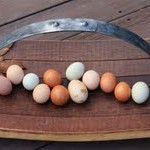
An array of jewels. Photo by Lisa Ramlo.
Are brown-shelled eggs better than white-shelled ones? Supermarkets sell all sorts of eggs. Brown or white shell. Free range or not. Organic. Vegan. Prices per dozen vary greatly. How is a consumer supposed to buy the freshest and tastiest egg?
We’ve been raising chickens for decades and have kept hens that lay white, brown, and even blue and green-shelled eggs. All are laid by birds of the very same species. The nutritional value of an egg is the same no matter what its shell color. Taste varies depending on how fresh the egg is and what the hen ate. It is independent of shell color.
Brown Eggs: Most supermarket brown eggs are laid by hybrid hens, often called ISA Browns. These were developed from the somewhat large Rhode Island Red breed. They may be raised in cages in enormous factory farms or come from a smaller free-range flock. Brown-shelled eggs may be free-range or organic……or not.
White Eggs: Almost all supermarket white eggs are laid by White Leghorn hybrids. They are smaller-bodied hens than brown egg layers and are commonly raised in cages in enormous chicken factory farms.
Blue or Green Eggs: Rarely seen in supermarkets, these beautiful eggs are laid by the Araucana breed or hybrids developed from them. These hens are common in backyard flocks.
Organic: If labeled organic the hens are supposed to have been fed feed raised according to organic standards. Eggs marked vegan or natural may or may not be organic. Be wary of vegan eggs, as hens are omnivores. If they encounter insects, worms or meat scraps they’ll readily devour them.
Cage Free: The hens that laid these eggs normally are crammed into a large building but are not confined to the tight space of a cage. They may, or may not, have access to the outdoors.
Free Range: This is tricky. Supposedly free-range hens have ready access to the outdoors, but there may be only a tiny outdoor run for thousands of hens to enjoy.
How To Tell If Eggs Are Fresh

Store-bought eggs are a pale yellow with runny whites. Fresh eggs radiate a golden hue centered in a firm albumen.
Nearly all egg cartons claim that the eggs inside are fresh, but what does that mean? They could have been laid six weeks earlier. To tell if an egg is fresh, fill a deep bowl with water and gently put an egg on the surface. If it sinks it’s reasonably fresh. If it floats it’s old. The reason is, a fresh egg has a small air cell. As it ages, moisture leaves through the porous shell and the air cell grows, making the egg buoyant.
The white, or albumen, of a fresh egg, will be relatively deep when cracked into the frying pan. It will spread out widely and be flat in an old egg.
How to Tell if Hens are Truly Pastured Raised
Most commercial eggs come from hens fed a specially prepared diet that provides all the nutrients they need but little else. The eggs will have pale yolks. In contrast eggs laid by hens with ready access to green vegetation will lay eggs with deep orange or yellow yolks. Some premium chicken feeds include marigold petals that impart deep color to the yolks.
Choosing the Highest Quality Eggs
It may take buying several dozen differently marketed eggs to find the freshest, tastiest, and most attractive eggs. Although the least expensive eggs usually come from factory farms, the best eggs aren’t always the most expensive. The very best will be fresh and have a boldly colored yolk.
For information on chicken breeds scan the Hoover’s Hatchery Website . For general information on eggs and recipes check out the website of the Egg Industry Center.





















